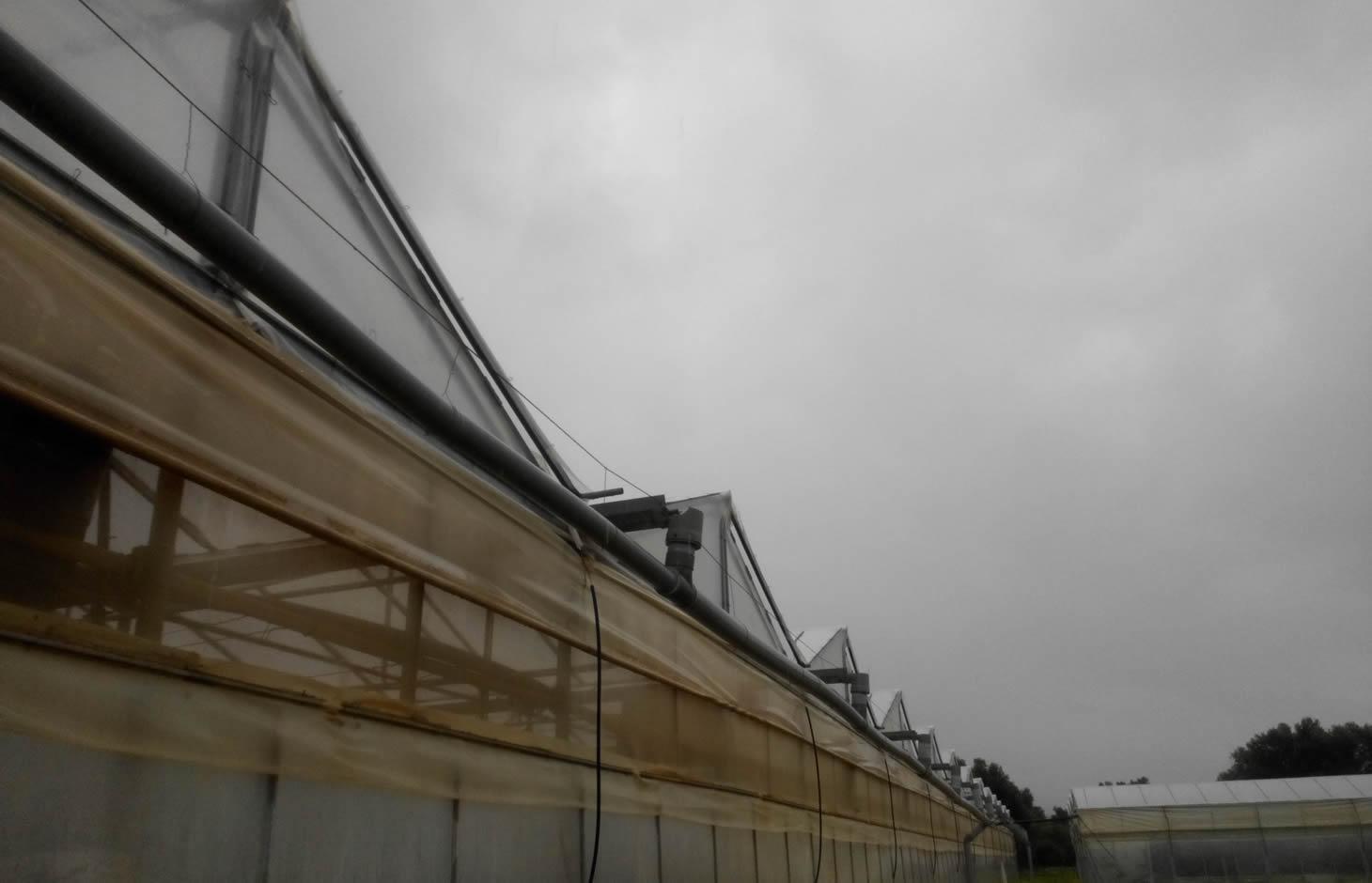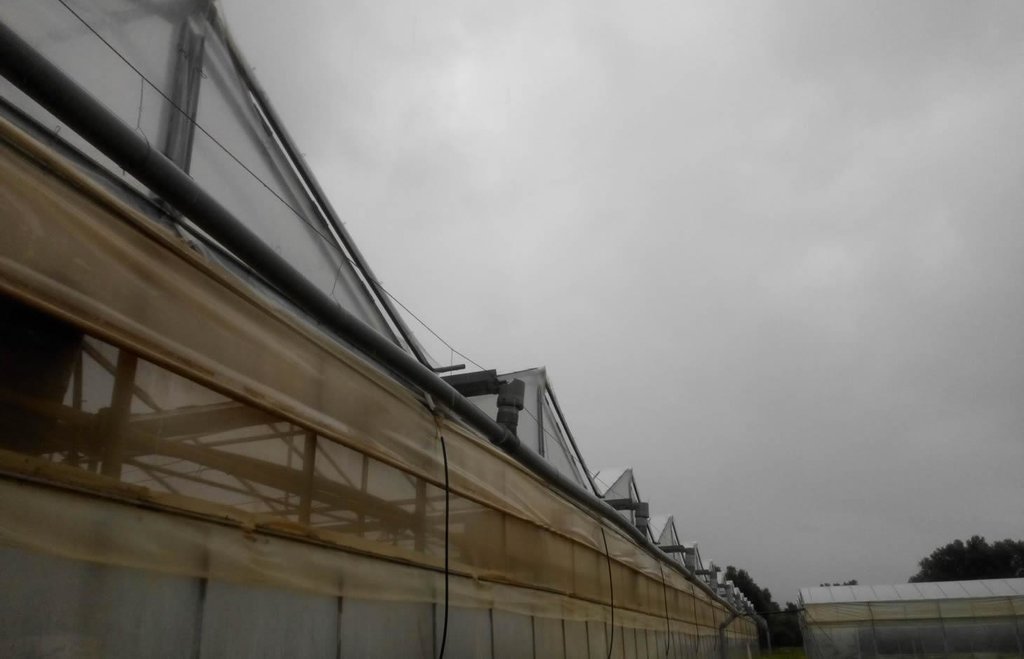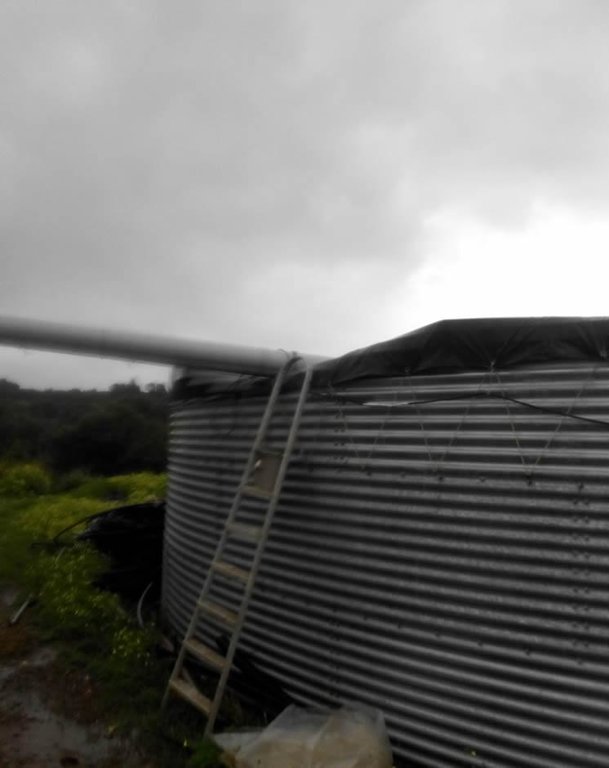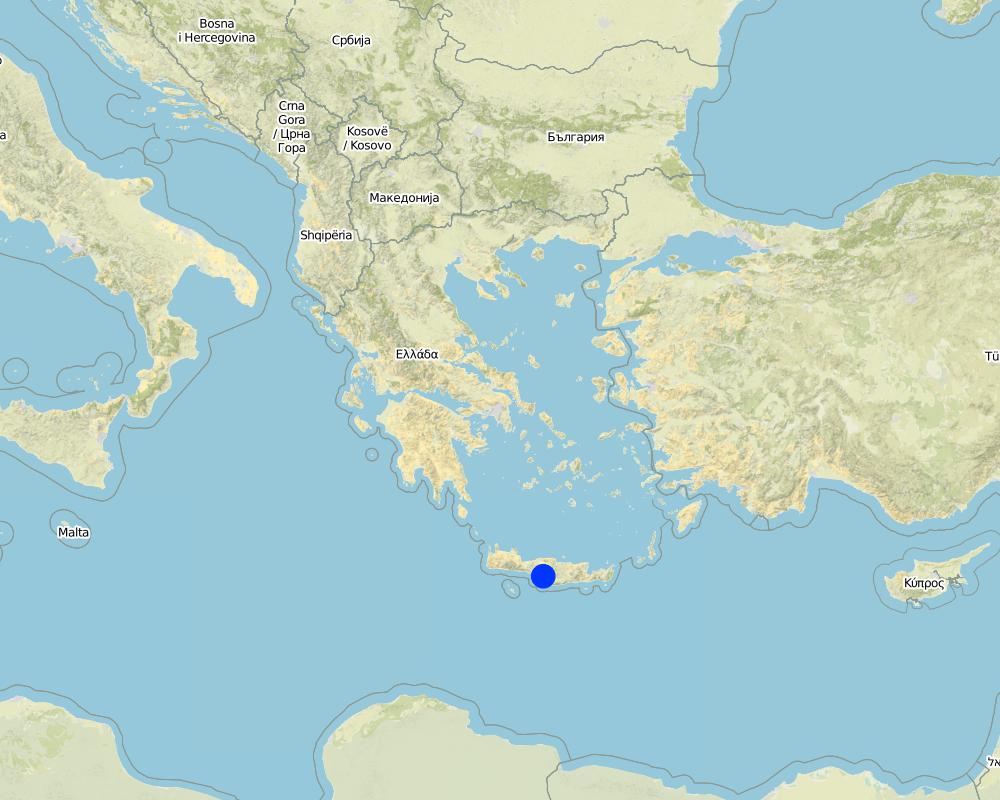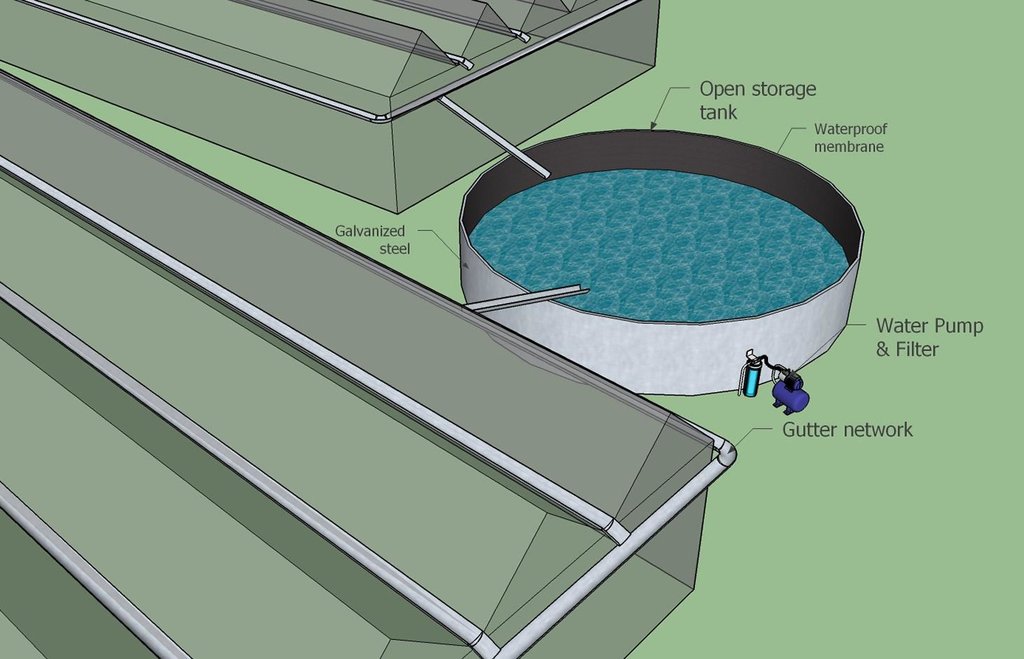Rainwater harvesting for greenhouse irrigation [Grécia]
- Criação:
- Atualização:
- Compilador/a: Ioanna Panagea
- Editor: –
- Revisores: Deborah Niggli, Alexandra Gavilano
Σύστημα συγκομιδής ομβρίων υδάτων από θερμοκήπια με σκοπό την άρδευση
technologies_1658 - Grécia
Veja as seções
Expandir tudo Recolher tudo1. Informação geral
1.2 Detalhes do contato das pessoas capacitadas e instituições envolvidas na avaliação e documentação da tecnologia
Especialista em GST:
Nome do projeto que facilitou a documentação/avaliação da Tecnologia (se relevante)
Preventing and Remediating degradation of soils in Europe through Land Care (EU-RECARE )Nome da(s) instituição(ões) que facilitou(ram) a documentação/ avaliação da Tecnologia (se relevante)
Technical University of Crete (Technical University of Crete) - Grécia1.3 Condições em relação ao uso da informação documentada através de WOCAT
O compilador e a(s) pessoa(s) capacitada(s) aceitam as condições relativas ao uso de dados documentados através do WOCAT:
Sim
1.4 Declaração de sustentabilidade da tecnologia descrita
A tecnologia descrita aqui é problemática em relação a degradação da terra de forma que não pode ser declarada uma tecnologia de gestão sustentável de terra?
Não
2. Descrição da tecnologia de GST
2.1 Descrição curta da tecnologia
Definição da tecnologia:
Rain water harvesting from greenhouses roofs.
2.2 Descrição detalhada da tecnologia
Descrição:
The roof of a greenhouse is used as catchment area for rainwater harvesting. A system of gutters is installed to channel water into a storage facility that can be either above ground or at ground level, open or covered. The water harvested from the roofs is used for irrigation purposes, either on its own or mixed with other sources.
In central and eastern Crete, a negative water balance emerges due to agricultural exploitation and lack of sustainable water resources management. Regarding water availability, it is notable that the spatial and temporal variability of precipitation are the limiting factors, rather than overall precipitation quantity. Especially in coastal areas where the main source of irrigation is groundwater, seawater intrusion often takes place, and eventually leading to irrigation with saline water. In the intensive agriculture and water stress conditions existing in greenhouses this situation can progressively lead to soil salinisation with subsequent adverse effects on production. The technology promotes sustainable land management through prevention and mitigation of land degradation by increasing water resources self-sufficiency thus allowing the user to rely less on the scarce groundwater resources and reduce the risk of production failure. Furthermore, the technology improves the overall irrigation water quality. The main disadvantage of the technology is the increase of agricultural inputs (fertilizers) because of the lack of minerals necessary for the crops (especially tomatoes) in the rainwater. This disadvantage can be mitigated by mixing rainwater with other sources.
The majority of the greenhouses in the region normally have built-in gutters between the basic construction units in order to discharge rainwater from the roof for structural safety. Thus, initially little structural measures are required including the implementation of some further gutters that channel rainwater in the storage system and preparation of the area for the tank installation. Overland tanks may consist of galvanized steel or similar material. Ground level storage usually requires earth removal. In both case, the installation of the relevant waterproofing material is required to avoid leaks. A cover may also be installed to reduce evaporation. Here we assess the use of a harvesting system comprising of (a) an above ground circular tank made out of galvanized steel with total volume of 320 m3 and (b) a gutter network spreading on the roof of a 0.7 ha greenhouse. Furthermore, a water filter and water treatment may be required for removal of particles and waterborne disease mitigation. Finally, a suitable pump and mixing facilities are installed to control water quality and quantity.
The average annual precipitation in the area is 500 mm and the climate ranges between sub-humid Mediterranean and semi-arid. Average annual temperature is 18.5 °C with 6 months below 18 °C but above 5 °C, thus classifying the area as subtropical. In the location where the technology is applied, land is mostly privately owned and water rights can be public, cooperative or private. Although the financial means of the land user who applies this technology are more or less on par with those of the rest of the community, he has a wider empirical education and relatively higher social status acquired thought his involvement with the commons and the water resources management of the region.
This Technology was documented within the scope of FP7 RECARE Project, funded grant agreement no 603498.
2.3 Fotos da tecnologia
2.5 País/região/locais onde a tecnologia foi aplicada e que estão cobertos nesta avaliação
País:
Grécia
Região/Estado/Província:
Heraklion
Especificação adicional de localização:
Timpaki
Comentários:
Total area covered by the SLM Technology is 0.007 km2.
Map
×2.6 Data da implementação
Caso o ano exato seja desconhecido, indique a data aproximada:
- 10-50 anos atrás
2.7 Introdução da tecnologia
Especifique como a tecnologia foi introduzida:
- através de projetos/intervenções externas
Comentários (tipos de projeto, etc.):
The land user has implemented the water harvesting technology in order to be subsidized from an agri-environmental scheme under the CAP.
3. Classificação da tecnologia de GST
3.2 Tipo(s) atualizado(s) de uso da terra onde a tecnologia foi aplicada

Terra de cultivo
- Cultura anual
- tomatoes
Número de estações de cultivo por ano:
- 1
Especifique:
Longest growing period in days: 270, Longest growing period from month to month: October to June

Assentamentos, infraestrutura
- Assentamentos, edificações
Comentários:
Major land use problems (compiler’s opinion): The main problem in the region is the change in the groundwater quality, caused by groundwater over-exploitation and the subsequent seawater intrusion, resulting in soil salinisation through irrigation.
Major land use problems (land users’ perception): The limited availability of good quality (non-saline) water for irrigation resulting in increased production risk and agricultural inputs.
3.4 Abastecimento de água
Abastecimento de água para a terra na qual a tecnologia é aplicada:
- Irrigação completa
3.5 Grupo de GST ao qual pertence a tecnologia
- Coleta de água
- Gestão de irrigação (inclusive abastecimento de água, drenagem)
3.6 Medidas de GST contendo a tecnologia

Medidas estruturais
- S5: Represa, bacia, lago
- S11: Outros
Comentários:
Main measures: structural measures
Specification of other structural measures: Greenhouse roof gutter network
3.7 Principais tipos de degradação da terra abordados pela tecnologia

Deteriorização química do solo
- Cs: salinização/alcalinização

Degradação biológica
- Bq: quantidade/ declínio da biomassa

Degradação da água
- Hg: mudança no lençol freático/aquífero
Comentários:
Main type of degradation addressed: Cs: salinisation / alkalinisation, Hg: change in groundwater / aquifer level
Secondary types of degradation addressed: Bq: quantity / biomass decline
Main causes of degradation: over abstraction / excessive withdrawal of water (for irrigation, industry, etc.) (Overpumping.), other human induced causes (specify) (Irrigation with brackish water.), droughts (Lack of sustainable water resources.), inputs and infrastructure: (roads, markets, distribution of water points, other, …) (Poor coverage of freshwater irrigation network.)
Secondary causes of degradation: soil management (Intensive cultivation), disturbance of water cycle (infiltration / runoff) (Covering of land with green houses decreases leaching.)
3.8 Redução, prevenção ou recuperação da degradação do solo
Especifique o objetivo da tecnologia em relação a degradação da terra:
- Prevenir degradação do solo
- Reduzir a degradação do solo
4. Especificações técnicas, implementação de atividades, entradas e custos
4.1 Desenho técnico da tecnologia
Especificações técnicas (relacionada ao desenho técnico):
A network of gutters channels rainwater to an adequately insulated metal tank. The stored water is then used for irrigation.
Location: Timpaki. Heraklion, Crete, Greece
Date: 31/3/2015
Technical knowledge required for field staff / advisors: moderate
Technical knowledge required for land users: moderate
Main technical functions: water harvesting / increase water supply, improvement of water quality, buffering / filtering water
Secondary technical functions: increase of groundwater level / recharge of groundwater
Dam/ pan/ pond
Height of bunds/banks/others (m): 2.7
Width of bunds/banks/others (m): 12.3
Structural measure: gutter network
Length of bunds/banks/others (m): 210
Construction material (other): Plastic gutters on the greenhouses roofs, galvanized steel & wateproof membrane for the tank
Specification of dams/ pans/ ponds: Capacity 320m3
Catchment area: 7000m2m2
Beneficial area: 7000m2m2
For water harvesting: the ratio between the area where the harvested water is applied and the total area from which water is collected is: 1:1
Autor:
Ioannis Daliakopoulos
4.2 Informação geral em relação ao cálculo de entradas e custos
Outro/moeda nacional (especifique):
Euro
Se for relevante, indique a taxa de câmbio do USD para moeda local (por exemplo, 1 USD = 79,9 Real): 1 USD =:
0,93
4.3 Atividades de implantação
| Atividade | Periodicidade (estação do ano) | |
|---|---|---|
| 1. | Construction of the tank base (including material transportation) | |
| 2. | Tank construction (including material transportation) | |
| 3. | Installation of the plastic gutters | |
| 4. | Pump and cleaning filter |
4.4 Custos e entradas necessárias para a implantação
| Especifique a entrada | Unidade | Quantidade | Custos por unidade | Custos totais por entrada | % dos custos arcados pelos usuários da terra | |
|---|---|---|---|---|---|---|
| Mão-de-obra | Labour | 1,0 | 858,0 | 858,0 | 60,0 | |
| Equipamento | pump | 1,0 | 536,0 | 536,0 | 60,0 | |
| Equipamento | cleaning filter | 1,0 | 536,0 | 536,0 | 60,0 | |
| Material de construção | galvanized steel | 1,0 | 3379,0 | 3379,0 | 60,0 | |
| Material de construção | waterproof membrane | 1,0 | 2360,0 | 2360,0 | 60,0 | |
| Material de construção | sand | 1,0 | 675,0 | 675,0 | 60,0 | |
| Material de construção | concrete | 1,0 | 290,0 | 290,0 | 60,0 | |
| Outros | gutters | 1,0 | 2252,0 | 2252,0 | 60,0 | |
| Custos totais para a implantação da tecnologia | 10886,0 | |||||
| Custos totais para o estabelecimento da Tecnologia em USD | 11705,38 | |||||
Comentários:
Duration of establishment phase: 0.5 month(s)
4.5 Atividades recorrentes/manutenção
| Atividade | Periodicidade/frequência | |
|---|---|---|
| 1. | Maintenance costs are negligible, e.g. filters are cleaned with water when needed. Fuel can't be accurately estimated as it depends on the machine hours that the pump works to irrigate. Two considerations: 1.Practically, the pump would have to work regardless of the water harvesting system. 2.The water harvesting system is irrelevant of the pumping scheme. |
4.6 Custos e entradas necessárias pata a manutenção/atividades recorrentes (por ano)
Comentários:
The cost described are calculated in current prices for the whole construction.
4.7 Fatores mais importantes que afetam os custos
Descreva os fatores mais determinantes que afetam os custos:
The greater deterrent against implementing the technology is the high cost of the tank construction.
5. Ambiente natural e humano
5.1 Clima
Precipitação pluviométrica anual
- <250 mm
- 251-500 mm
- 501-750 mm
- 751-1.000 mm
- 1.001-1.500 mm
- 1.501-2.000 mm
- 2.001-3.000 mm
- 3.001-4.000 mm
- > 4.000 mm
Especificações/comentários sobre a pluviosidade:
About 400-500 mm annually
Zona agroclimática
- Subúmido
- Semiárido
Thermal climate class: subtropics. 6 months below 18 °C but above 5 °C
5.2 Topografia
Declividade média:
- Plano (0-2%)
- Suave ondulado (3-5%)
- Ondulado (6-10%)
- Moderadamente ondulado (11-15%)
- Forte ondulado (16-30%)
- Montanhoso (31-60%)
- Escarpado (>60%)
Formas de relevo:
- Planalto/planície
- Cumes
- Encosta de serra
- Encosta de morro
- Sopés
- Fundos de vale
Zona de altitude:
- 0-100 m s.n.m.
- 101-500 m s.n.m.
- 501-1.000 m s.n.m.
- 1.001-1.500 m s.n.m.
- 1.501-2.000 m s.n.m.
- 2.001-2.500 m s.n.m.
- 2.501-3.000 m s.n.m.
- 3.001-4.000 m s.n.m.
- > 4.000 m s.n.m.
5.3 Solos
Profundidade do solo em média:
- Muito raso (0-20 cm)
- Raso (21-50 cm)
- Moderadamente profundo (51-80 cm)
- Profundo (81-120 cm)
- Muito profundo (>120 cm)
Textura do solo (solo superficial):
- Médio (limoso, siltoso)
Matéria orgânica do solo superficial:
- Alto (>3%)
Caso disponível anexe a descrição completa do solo ou especifique as informações disponíveis, p. ex. tipo de solo, PH/acidez do solo, nitrogênio, capacidade de troca catiônica, salinidade, etc.
Soil texture characterized mainly as sandy clay loam or clay loam
5.4 Disponibilidade e qualidade de água
Lençol freático:
5-50 m
Disponibilidade de água de superfície:
Médio
Qualidade da água (não tratada):
apenas para uso agrícola (irrigação)
Comentários e outras especificações sobre a qualidade e a quantidade da água:
Water quality (treated): good drinking water
5.5 Biodiversidade
Diversidade de espécies:
- Baixo
5.6 Características dos usuários da terra que utilizam a tecnologia
Sedentário ou nômade:
- Sedentário
Orientação de mercado do sistema de produção:
- Comercial/mercado
Rendimento não agrícola:
- Menos de 10% de toda renda
Nível relativo de riqueza:
- Média
- Rico
Indivíduos ou grupos:
- Indivíduo/unidade familiar
Nível de mecanização:
- Trabalho manual
- Mecanizado/motorizado
Gênero:
- Homens
Indique outras características relevantes dos usuários da terra:
Land users applying the Technology are mainly common / average land users
Population density: 10-50 persons/km2
Annual population growth: 1% - 2%
5.7 Área média de terrenos utilizados pelos usuários de terrenos que aplicam a Tecnologia
- < 0,5 ha
- 0,5-1 ha
- 1-2 ha
- 2-5 ha
- 5-15 ha
- 15-50 ha
- 50-100 ha
- 100-500 ha
- 500-1.000 ha
- 1.000-10.000 ha
- > 10.000 ha
É considerado pequena, média ou grande escala (referente ao contexto local)?
- Média escala
5.8 Propriedade de terra, direitos de uso da terra e de uso da água
Propriedade da terra:
- Indivíduo, intitulado
Direitos do uso da terra:
- Arrendado
- Indivíduo
- Cooperative
Direitos do uso da água:
- Comunitário (organizado)
- Indivíduo
- Cooperative
5.9 Acesso a serviços e infraestrutura
Saúde:
- Pobre
- Moderado
- Bom
Educação:
- Pobre
- Moderado
- Bom
Assistência técnica:
- Pobre
- Moderado
- Bom
Emprego (p. ex. não agrícola):
- Pobre
- Moderado
- Bom
Mercados:
- Pobre
- Moderado
- Bom
Energia:
- Pobre
- Moderado
- Bom
Vias e transporte:
- Pobre
- Moderado
- Bom
Água potável e saneamento:
- Pobre
- Moderado
- Bom
Serviços financeiros:
- Pobre
- Moderado
- Bom
6. Impactos e declarações finais
6.1 Impactos no local mostrados pela tecnologia
Impactos socioeconômicos
Produção
Produção agrícola
Risco de falha de produção
Renda e custos
Despesas com insumos agrícolas
Comentários/especificar:
softer water (rainwater) requires more expensive fertilisers
Outros impactos socioeconômicos
production area
Comentários/especificar:
Depending on relative farm size.
Impactos socioculturais
Segurança alimentar/auto-suficiência
Conhecimento de GST/ degradação da terra
Contribution to human well-being
Comentários/especificar:
The technology reduces production risk and increases self sufficiency for the user who implements it. If the technology is widely implemented this will have a positive impact on the soil sustainability of the area thus allowing agricultural exploitation for longer. It will also greatly reduce water use conflicts, thus contributing to the general well-being of the local community.
Impactos ecológicos
Ciclo hídrico/escoamento
Quantidade de água
Qualidade de água
Colheita/recolhimento de água
Solo
Umidade do solo
Salinidade
6.2 Impactos externos mostrados pela tecnologia
Disponibilidade de água
Danos em áreas vizinhas
Comentários/especificar:
control of the water from the greenhouses roofs.
Danos na infraestrutura pública/privada
Comentários/especificar:
control of the water from the greenhouses roofs.
6.3 Exposição e sensibilidade da tecnologia às mudanças climáticas graduais e extremos/desastres relacionados ao clima (conforme o ponto de vista dos usuários da terra)
Mudança climática gradual
Mudança climática gradual
| Estação do ano | aumento ou diminuição | Como a tecnologia lida com isso? | |
|---|---|---|---|
| Temperatura anual | aumento | bem |
Extremos (desastres) relacionados ao clima
Desastres climatológicos
| Como a tecnologia lida com isso? | |
|---|---|
| Seca | não bem |
Outras consequências relacionadas ao clima
Outras consequências relacionadas ao clima
| Como a tecnologia lida com isso? | |
|---|---|
| Decrease of water temperature | não bem |
Comentários:
The optimum water temperature for the crops cultivated in the greenhouse (tomatoes) is about 20 °C. If water temperature is less than 14 °C then the land user has to rely on an alternative source.
6.4 Análise do custo-benefício
Como os benefícios se comparam aos custos de implantação (do ponto de vista dos usuários da terra)?
Retornos a curto prazo:
negativo
Retornos a longo prazo:
positivo
Como os benefícios se comparam aos custos recorrentes/de manutenção(do ponto de vista dos usuários da terra)?
Retornos a curto prazo:
positivo
Retornos a longo prazo:
muito positivo
Comentários:
In the long term soil health is greatly maintained.
6.5 Adoção da tecnologia
- > 50%
Se disponível, determine a quantidade (número de unidades familiares e/ou área abordada):
70% or 7 land user families
De todos aqueles que adotaram a Tecnologia, quantos o fizeram espontaneamente, ou seja, sem receber nenhum incentivo/ pagamento material?
- 11-50%
Comentários:
30% of land user families have adopted the Technology without any external material support
3 land user families have adopted the Technology without any external material support
Comments on spontaneous adoption: Land users are probably not able to afford or justify the cost without external material support.
There is a little trend towards spontaneous adoption of the Technology
Comments on adoption trend: Word of mouth conveys the successful results and several users are eager to adopt the technology but not without external material support.
6.7 Pontos fortes/vantagens/oportunidades da tecnologia
| Pontos fortes/vantagens/oportunidades na visão do usuário da terra |
|---|
| Increased irrigation water availability, and security; reduced crop failure risk; ability to diversify or intensify production |
| Pontos fortes/vantagens/oportunidades na visão do compilador ou de outra pessoa capacitada |
|---|
| Self-sufficiency of water; sustainable agriculture management (soil protection and conservation) and reduced failure risk; decreased soil salinity |
6.8 Pontos fracos, desvantagens/riscos da tecnologia e formas de superá-los
| Pontos fracos/desvantagens/riscos na visão do usuário da terra | Como eles podem ser superados? |
|---|---|
| High construction cost. | The construction of a water harvesting system for greenhouses can be subsidized. |
| Tomato cultivation requires water with higher electric conductivity than that of rainwater, therefore increased agricultural inputs may be required to treat the harvested rainwater. | Rainwater may be mixed with brackish water at a prescribed ratio. |
| Pontos fracos/vantagens/riscos na visão do compilador ou de outra pessoa capacitada | Como eles podem ser superados? |
|---|---|
| Is dependent on climatic conditions (precipitation/evaporation) | During dry years the storage tank can be used as a buffer from other sources. Installing a cover reduces evaporation. |
| High construction cost. | The construction of a water harvesting system for greenhouses can be made obligatory. |
| The storage area decreases the area available for cultivation (or can't be established in very small properties) |
7. Referências e links
7.1 Métodos/fontes de informação
- visitas de campo, pesquisas de campo
- entrevistas com usuários de terras
Quando os dados foram compilados (no campo)?
06/03/2015
Links e módulos
Expandir tudo Recolher tudoLinks
Não há links
Módulos
Não há módulos


